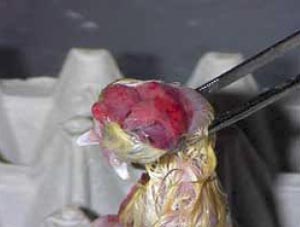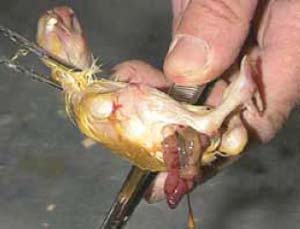



Investigating Hatchery Practice - Interpretation of Quality Control Test Results
In the ninth article in this series, Dr Steve Tullett, consultant for Aviagen specialising in incubation and fertility, describes how to interpret the results of a hatchery investigation, following the previous article in the series, which covered how to carry out the investigation. The article forms part of a recently published Ross Tech publication, Investigating Hatchery Practice.Many hatchability and chick quality problems can be solved by careful analysis of the data gathered using the techniques described in this publication. Some possible causes of losses at different stages of development are considered below.
Excess infertiles
No visible embryonic growth. The dense white area characteristic of the infertile blastodisc may be seen if the eggs are candled and examined early in incubation. It may not be obvious after the full incubation period.
Possible causes: Immature males, males not mating because they are overweight or have foot problems. Males losing condition due to insufficient feed. Mating ratio too high or too low. Females avoiding males because they are, or have been, too vigorous (i.e. overmating). Disease.
Excess early dead embryos (set to two days)
There may be no obvious embryo, but the growth of the cream coloured extra-embryonic membranes should be evident (up to one centimetre diameter by one day of age, up to three centimetres in diameter by two days of incubation) if eggs are candled and broken out early in incubation. There is no blood present.
Possible causes: Most likely to be a farm, transport or storage problem. For example, infrequent egg collection. jarring in handling or transport, eggs not allowed to settle at hatchery before setting, eggs stored too long (i.e. longer than seven days) or stored in unsuitable conditions (i.e. too cold, too warm or fluctuating temperature). Incorrect disinfection of eggs (e.g. washing at too high a temperature or fumigation in the first 12 to 96 hours of incubation) or high early incubation temperatures are other possible causes.
Excess 'Blood Ring' (embryonic death from 2.5 to 4 days)
Cream-coloured membrane growing over the surface of yolk and a circulatory system with obvious blood should have developed. After the embryo dies, the blood vessels are not obvious because the blood flows into the peripheral ring and becomes darker in colour. The peripheral 'Blood Ring' usually survives to transfer but the remnants of the cream-coloured extra-embryonic membranes and the presence of the fluid-filled amniotic sac on top of the yolk may be the only evidence after 21 days of incubation. There is no obvious black pigmentation in the eye.
Possible causes: Same as for early dead embryos, with the possibility also of nutritional deficiency or bacterial contamination.
Excess 'Black Eye' (embryonic death from 5 to 12 days)
The embryo will have developed an obvious black-coloured eye. Small wings and legs are also clearly visible. Embryos that die at this stage are often contaminated.
Possible causes: Bacterial contamination caused by cracked eggshells, poor nest hygiene, inappropriate egg disinfection or sweating of eggs due to a sudden change in temperature and/or humidity during any egg handling procedures. Often associated with floor eggs, especially those that have been washed. Possibility of a nutritional cause.
Excess 'Feathers' (embryonic death from 13 to 17 days)
Feathers start to appear at about 11 days of incubation, but may not be obvious over all the body until day 13. Dead-in-shell embryos in this category do not quite fill the shell. The head tends to be in the pointed end of the shell. In the hatch debris, the egg contents of embryos dying during the 'Feathers' stage are often a dark reddish-brown colour due to the decomposing blood.
Possible causes: Most embryos tend to survive this period of rapid growth. However, nutritional deficiencies will increase mortality at this stage, as will contamination and inappropriate incubation conditions.
Excess of 'turned' embryos (embryonic deaths from 18 to 19 days)
The embryo fills the egg and the head has 'turned' to the air cell in the blunt end of the shell. The yolk sac is still outside the abdomen. The chick should be examined for signs of developmental abnormalities, excessive moisture or an upside down malposition.
Possible causes: Inappropriate temperature or humidity in the setter or hatcher. Damage at transfer. Nutritional deficiencies or egg contamination will increase mortality at this stage. Turning problems in the setter, i.e. frequency of turning or angle of turning. Egg set upside down. An excess of moisture in the egg associated with low egg weight loss due to high humidity in the setters.
Excess pipped air cells
The embryo fills the shell, and the beak has penetrated the air cell in the blunt end of the shell. The yolk sac is mostly or entirely inside the abdomen. Developmental abnormalities may be visible.
Possible causes: Same as for an excess of 'turned' embryos, but also possibility of humidity being too high after transfer.
Excess pipped shells
Fully formed embryo has made a hole in the shell but has not emerged. It may be alive or dead at the time of opening.
Possible causes: Low humidity, high temperatures or inadequate ventilation in the hatcher. Inadequate turning or eggs set upside down. Nutritional deficiencies or disease can also increase mortality at this stage, as can excessive egg storage time, transfer damage or excessive fumigation during hatching.
Malformations
Head
For example, exposed brain, missing eye(s), beak and/or face abnormality (Figure 29).
Possible causes: High early incubation temperatures or nutritional deficiency.

Legs and toes
Shortened, bent or twisted legs, malformed toes. Lameness in hatched chicks.
Possible causes: Nutritional deficiency. Paper in bottom of hatcher baskets too smooth.
Ectopic viscera
Intestines are outside the abdominal cavity of an otherwise fully developed chick (Figure 30).
Possible causes: High setter temperatures during mid-incubation.

Extra limbs
Extra legs and/or wings.
Possible causes: Rough handling/jarring of eggs during collection and/or transport.
Further Reading
| - | You can see other articles in this series Investigating Hatchery Practice by clicking here. |
February 2010









